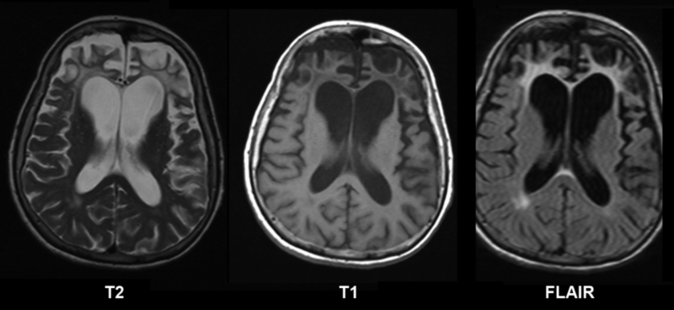Frontotemporal Dementia
This article is currently under review and may not be up to date. Please come back soon to see the finished work!
Description[edit | edit source]
The term “Pick’s Disease” (PiD) was named after Arnold Pick for his initial description of focal gross atrophy of the frontotemporal lobes in a patient with progressive language and behavioral disturbances [1]. Pick’s disease is a rare neurodegenerative disorder, estimated to be 10 times less frequent than Alzheimer’s disease, even in regions with high prevalence. It was first clinically described by Pick in 1892, in a woman with lobar brain atrophy who suffered from pre-senile dementia with dysphasia [2]. Current knowledge indicates that PiD is a member of a group of heterogeneous neurodegenerative disorders with similar or related histopathologic and clinical features [3]. Pick Disease,” or “Pick’s Disease” is the name given to one form of a larger group of diseases now called the Frontotemporal Dementia (FTD) [4] .
Causes[edit | edit source]
Pick’s disease, along with other FTDs, is caused by abnormal amounts or types of nerve cell proteins, called tau. These proteins are found in all of our nerve cells. They are usually stored in Pick bodies or Pick cells causing the brain tissue to shrink and leading to dementia [5].
Symptoms[edit | edit source]
Pick's Disease is a progressive dementia charaterized by progressive changes leading to impairment of intellect, memory and language [5]. The following symptoms may be experienced:
- Behavorial and emotional symptoms such as: [5]
- Abrupt mood changes
- Compulsive or inappropriate behavior
- Depression-like symptoms like disinterest in activities of daily life
- Withdrawal from social interaction
- Poor social skills
- Difficulty in keeping a job
- Poor social
- Poor personal hygiene
- Repetitive behavior
2. Language changes such as: [6]
- Hesitant speech
- Difficulty articulating
- Stuttering
- Ungrammatical speech
- Difficulty recalling words or names
3. Neurological changes such as: [5]
- Accelerated memory loss
- Physical weakness
Diagnosis[edit | edit source]
Many different tools are used to diagnose PiD or FTD. The medical history of the patient as well as special imaging tests and lab tests are some of the tools to help make a diagnosis. The diagnosis is made on a clinical basis, although genetic testing can confirm some specific subtypes [4].
- Medical history [5]
- The patient is asked to complete speech and writing tests.
- Physical and neurological examination is done. Interviews with family members are conducted to learn more about his behavior.
- Neuropsychological testing to pinpoint and document a person’s cognitive problems and strengths.
2. Special Imaging Test [7]
- Brain scans examine the brain to detect atrophy and other abnormalities in the frontal and temporal lobes. They can also rule out other conditions such as brain tumors or stroke.
- MRI (to show atrophy of the frontal and temporal lobes), CT Scan, SPECT and PET scans are the recommended ones.
- Electroencephalography (EEG) and Spinal tap (lumbar puncture) can be useful in some cases to rule out other conditions that can cause dementia.
- Blood Tests to rule out :
1. Possible causes of Dementia in older adults such as Hypothyroidism, Vitamin B-12 deficiency and Syphilis, Kidney or Liver problems
2. Infections
3. Blood disorders
4. Hormonal disorders
5. Chemical abnormalities
Treatment[edit | edit source]
As for Alzheimer's Disease, there is no cure for PiD or FTD. The treatment aims to relieve and/or improve symptoms. There are no specific medications for FTDs. they are symptom-oriented rather than disease-modifying or curative [4].
1.Drug Treatment
References[edit | edit source]
- ↑ Irwin DJ, Brettschneider J, McMillan CT, Cooper F, Olm C, Arnold SE, Van Deerlin VM, Seeley WW, Miller BL, Lee EB, Lee VM. Deep clinical and neuropathological phenotyping of Pick disease. Annals of neurology. 2016 Feb;79(2):272-87.
- ↑ Dickson DW. Pick's disease: a modern approach. Brain pathology. 1998 Apr;8(2):339-54.
- ↑ Hu W, Luo JJ. Research Advances in Pick’s Disease: A New Biomarker Candidate. J Neurol Neurophysiol. 2013;4:e112.
- ↑ 4.0 4.1 4.2 What is Pick’s Disease? Available from: https://www.brightfocus.org/alzheimers-disease/article/what-picks-disease (Accessed, 01/08/2021).
- ↑ 5.0 5.1 5.2 5.3 5.4 5.5 Pick Disease of the Brain: Causes, Symptoms, and Diagnosis. Available from: https://www.healthline.com/health/picks-disease#symptoms (Accessed, 01/08/2021).
- ↑ What is Pick’s Disease? Available from: https://www.alzheimers.net/what-is-picks-disease (Accessed, 04/08/2021).
- ↑ 7.0 7.1 Pick Disease. Available from: https://www.emedicinehealth.com/pick_disease/article_em.htm (Accessed, 05/08/2021).







